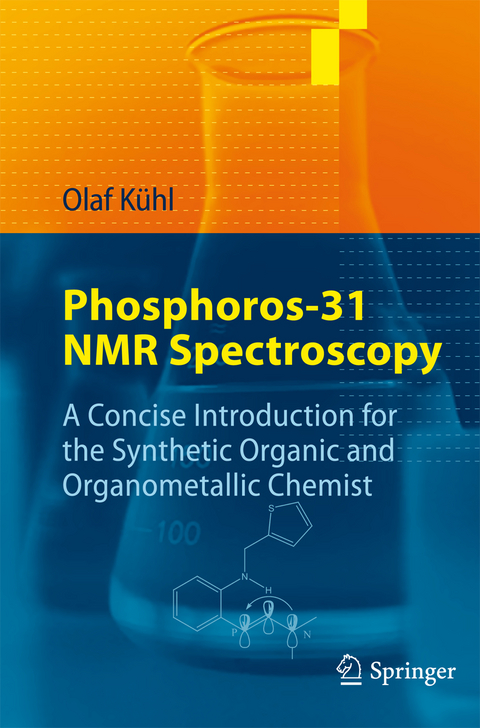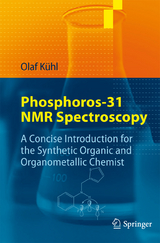Phosphorus-31 NMR Spectroscopy
Springer Berlin (Verlag)
978-3-540-79117-1 (ISBN)
Nuclear Magnetic Resonance is a powerful tool, especially for the identification of 1 13 hitherto unknown organic compounds. H- and C-NMR spectroscopy is known and applied by virtually every synthetically working Organic Chemist. Con- quently, the factors governing the differences in chemical shift values, based on chemical environment, bonding, temperature, solvent, pH, etc. , are well understood, and specialty methods developed for almost every conceivable structural challenge. Proton and carbon NMR spectroscopy is part of most bachelors degree courses, with advanced methods integrated into masters degree and other graduate courses. In view of this universal knowledge about proton and carbon NMR spectr- copy within the chemical community, it is remarkable that heteronuclear NMR is still looked upon as something of a curiosity. Admittedly, most organic compounds contain only nitrogen, oxygen, and sulfur atoms, as well as the obligatory hydrogen and carbon atoms, elements that have an unfavourable isotope distribution when it comes to NMR spectroscopy. Each of these three elements has a dominant isotope: 14 16 32 16 32 N (99. 63% natural abundance), O (99. 76%), and S (95. 02%), with O, S, and 34 14 S (4. 21%) NMR silent. N has a nuclear moment I = 1 and a sizeable quadrupolar moment that makes the NMR signals usually very broad and dif cult to analyse.
Olaf Kühl ist Privatdozent an der Universität Greifswald. Seine Forschungsschwerpunkte sind die metallorganische und bioanorganische Chemie. Nach dem Chemiestudium in Tübingen fertigte er seine Diplomarbeit in Vancouver und Adelaide an und promovierte in Leipzig. Postdoc-Aufenthalte in Greifswald und Dresden gaben ihm die Möglichkeit zur Habilitation, die er durch einen Lehrauftrag in Chemnitz, einer Gastprofessur in Alabama und zuletzt in Greifwald abschloss. Dort wurde er 2009 zum Leiter der bioanorganischen Forschungsgruppe ernannt. Seine Passion für die Wissensvermittlung zeigt sich unter anderem in über 50 Veröffentlichungen, 2 Büchern und 8 Patenten sowie seiner Tätigkeit als Editor einer wissenschaftlichen Zeitschrift.
Short Review of NMR Theory.- The Range of Chemical Shifts, Coupling Constants, and What Influences Each.- Oxidation State from P(-III) over P(0) to P(+V).- ?5-phosphanes.- ?3-Phosphanes.- Main Group Compounds.- Transition Metal Complexes.
lt;p>Aus den Rezensionen:
"... ein kompaktes Lehrbuch zur Phosphor-31-NMR-Spektroskopie. Aufbauend auf Grundwissen, das der Leser zu NMR ... haben muss, werden ... die spezifischen Eigenheiten des Phosphorkerns erläutert. ... Das Gewicht des Buches liegt eindeutig auf einer klaren und exakten, gut lesbaren Einführung zu den unterschiedlichsten Phosphorhaltigen organischen Verbindungen. Hier muss anerkannt werden, dass der Autor eine grosse Bandbreite an Strukturen und Komplexen und die Auswirkungen auf die chemische Verschiebung sehr gut bespricht. ... Die unterschiedlichen Kopplungen werden ... gut erklärt und Werte für Kopplungen im Text erwähnt ..." (http://www.organische-chemie.ch/buecher/besprechungen/3540791175.shtm)
| Erscheint lt. Verlag | 10.9.2008 |
|---|---|
| Zusatzinfo | XIV, 132 p. 145 illus. |
| Verlagsort | Berlin |
| Sprache | englisch |
| Maße | 155 x 235 mm |
| Gewicht | 244 g |
| Themenwelt | Naturwissenschaften ► Chemie ► Organische Chemie |
| Schlagworte | Analytical Chemistry • Hardcover, Softcover / Chemie/Organische Chemie • HC/Chemie/Organische Chemie • Kernresonanzspektroskopie • NMR • NMR spectroscopy • Organic Chemistry • Organometallic Chemistry • Phosphor • spectroscopy |
| ISBN-10 | 3-540-79117-5 / 3540791175 |
| ISBN-13 | 978-3-540-79117-1 / 9783540791171 |
| Zustand | Neuware |
| Haben Sie eine Frage zum Produkt? |
aus dem Bereich




